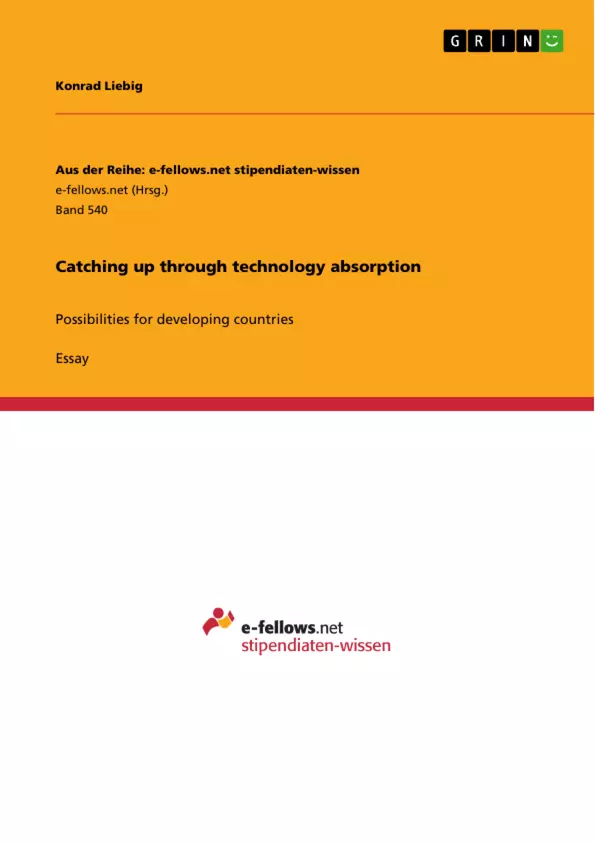A country´s economic performance and wealth is clearly linked to the degree of the country´s industrialization process. This process is in turn connected with the diffusion of technology within and into the country (Clark et al. 1993). In the special case of developing countries the next step of industrialization must not even be an innovative one because the technology already exists in developed countries (Henry/Kneller/Milner 2009). Additionally the absorption of newer technologies should even become easier the bigger the lag to the technical frontier becomes. Hence, it has to be questioned why many developing countries are not able to efficiently overtake and use technologies from developed countries to reduce their lack of development although those technologies seem to be so easily available. The expansion of information and communication technology should make the access to them even easier.
Another important point is that reaching a certain level of industrialization enables a country´s industry to be innovative itself by adjusting existing technologies or by creating new connections between different “old” technologies. In this way further development could be reached like the economic success stories of East Asian countries, e.g. South Korea, show. It has to be questioned which lessons today´s developing countries mainly in Africa can learn from these countries while keeping in mind that they do have other specific preconditions.
This essay is structured as follows. It starts with outlining some necessary definitions. It is followed by an observation which requirements developing countries need to successfully absorb technologies. Afterwards it provides a look at the special case of South Korea and its development that shows how technology absorption could look like in a developing country. Then the essay continues with a guideline for a government´s trade and technology policy before it ends with some final conclusions.
Inhaltsverzeichnis (Table of Contents)
- Introduction
- Definitions
- Requirements for the Absorption of Technologies
- Access to the Technology
- Ability to absorb technology
- Can Africa learn from Korea?
- What can the government do?
- Building up a proper education system
- The right Trade Policy
- Technology Policy
- Conclusion
Zielsetzung und Themenschwerpunkte (Objectives and Key Themes)
This essay explores the relationship between technology absorption and economic development, specifically focusing on the challenges and opportunities faced by developing countries. The main objective is to analyze the factors that influence the successful absorption of new technologies and to identify strategies that can facilitate this process in developing nations.
- The importance of technology absorption for economic development.
- The role of government policies in promoting technology absorption.
- The challenges and opportunities associated with technology transfer from developed to developing countries.
- The impact of trade and foreign investment on technology absorption.
- The lessons that developing countries can learn from successful cases of technology absorption in other countries, such as South Korea.
Zusammenfassung der Kapitel (Chapter Summaries)
- Introduction: This chapter establishes the connection between industrialization, technology diffusion, and economic performance, particularly in developing countries. It highlights the apparent ease of access to existing technologies in developed countries and questions why many developing countries struggle to effectively utilize them. The chapter introduces the concept of technology absorption as a pathway for catching up and emphasizes the role of education and innovation in achieving sustainable development.
- Definitions: This chapter defines key terms related to technology, innovation, and adoption. It clarifies the difference between product and process innovations and explains the distinction between diffusion and adoption of technologies, highlighting the microeconomic and macroeconomic perspectives of these processes. It also provides a brief characterization of developing countries, emphasizing their low GDP per capita and industrialization levels.
- Requirements for the Absorption of Technologies: This chapter examines the necessary requirements for successful technology absorption in developing countries. It argues that the mere availability of a technology is insufficient, and highlights the importance of access to the technology through various channels, such as trade, migration, and foreign investment. The chapter also emphasizes the critical role of a country's ability to utilize and benefit from the technology, which requires specific skills, knowledge, and institutional arrangements.
- Can Africa learn from Korea?: This chapter explores the specific case of South Korea as an example of successful technology absorption in a developing country. It aims to identify lessons that developing countries, particularly in Africa, can learn from South Korea's experience. This section likely examines the specific policies and factors that contributed to South Korea's economic success and analyzes their applicability to other developing nations, taking into account their specific circumstances.
- What can the government do?: This chapter delves into the role of government in fostering technology absorption. It outlines key policy areas that governments can focus on to facilitate the successful adoption of new technologies, including: building a strong education system, implementing appropriate trade policies, and developing targeted technology policies. This section likely provides concrete examples of successful policy interventions and analyzes their impact on technology absorption in different contexts.
Schlüsselwörter (Keywords)
This essay focuses on key concepts such as technology absorption, industrialization, economic development, developing countries, trade, foreign investment, innovation, diffusion, adoption, and government policies. The text explores the role of education, skills, and institutions in facilitating technology absorption and achieving sustainable economic growth.
- Quote paper
- Konrad Liebig (Author), 2010, Catching up through technology absorption, Munich, GRIN Verlag, https://www.grin.com/document/201889



